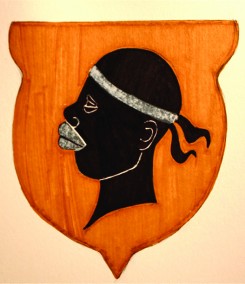A sambo image that hung in Hart House’s Debates Room was recently removed after it was reported offensive by staff and students.
Commissioned by Vincent Massey in 1919, the image is one of 16 painted wooden shields intended to depict aspects of Canadian identity. However, some critics say that the sambo image is a stereotypical caricature of a black person’s face.
 On November 10, Hart House interim Warden Bruce Kidd announced to the Board of Stewards his decision to remove the shield in accordance with U of T’s equity policy. “We strive to the best of our ability to make every [space] accessible, welcoming and affirming to all students, faculty, staff, and members of the public. In making this decision, I hope that I underline that message,” he said.
On November 10, Hart House interim Warden Bruce Kidd announced to the Board of Stewards his decision to remove the shield in accordance with U of T’s equity policy. “We strive to the best of our ability to make every [space] accessible, welcoming and affirming to all students, faculty, staff, and members of the public. In making this decision, I hope that I underline that message,” he said.
With this ruling, Kidd hoped that all persons of African heritage will continue to feel welcome and a part of Hart House.
On September 20, the OISE Centre for Urban Schooling hosted a workshop in the Debates Room on the Canadian context for equity and social justice teaching. Directly above their slide presentation hung the sambo image.
Professor Nicole West-Burns was one the instructors presenting that day. She was disturbed to see the image, and noted that the remaining fifteen shields displayed objects such as a sheaf of wheat, a fish, etc.
Immediately after the workshop, West-Burns and her colleagues reported the image to U of T administrators.
“When the issue around the Blackamoor head shield at Hart House was brought forward, Professor Kidd and I immediately met with the individuals to gain a full understanding of the issues,” said Lucy Fromowitz, Assistant Vice-President of Student Life.
“We had several meaningful conversations, and ultimately, Professor Kidd determined that the appropriate resolution was to remove the shield, and I fully support this decision,” she asserted.
West-Burns explained why the imagery was troublesome for her and others.
“For the first time in my career, I [was in] a space that felt overtly, systemically oppressive. And it was oppressive based on issues of race and racism,” she said.
“This image has no place in the modern world — not in an educational institution and certainly not in an institution of the University of Toronto’s calibre,” said Lloyd Wiredu, president of the National Society of Black Engineers at U of T. “It is offensive and unacceptable.”
Further consultation about the shield’s meaning was sought from experts in heraldry, visual art, and human rights. Kidd also consulted persons of African decent who explained the negative attributes of sambo imagery. West-Burns was pleased with Professor Kidd’s decision and handling of the situation.
“It makes a difference in how that space is received. It is a statement of how we need to try to move forward and make all spaces on this campus spaces where students’ social identity factors are not used against them to make them feel that they are not included or that they are less than [others]. I think it was the right decision,” said West-Burns.
Fromowitz agreed. “The University of Toronto has clear policies on equity, diversity, and excellence. Our values of inclusivity and respect for all members of our diverse society are meaningful to us.”
The president of the Black Students’ Association, Shauntel Parkinson, is also satisfied with the result.
“Any student of minority descent could feel the same level of offensiveness and exclusion if their group was depicted as an object, caricature, or rarity. It’s uncomfortable,” said Parkinson. “I’m thankful and respectful of the decision that Professor Kidd has made. It proves that he and the U of T administration are aware of the underlying equity issue and have taken the appropriate and necessary steps.”

